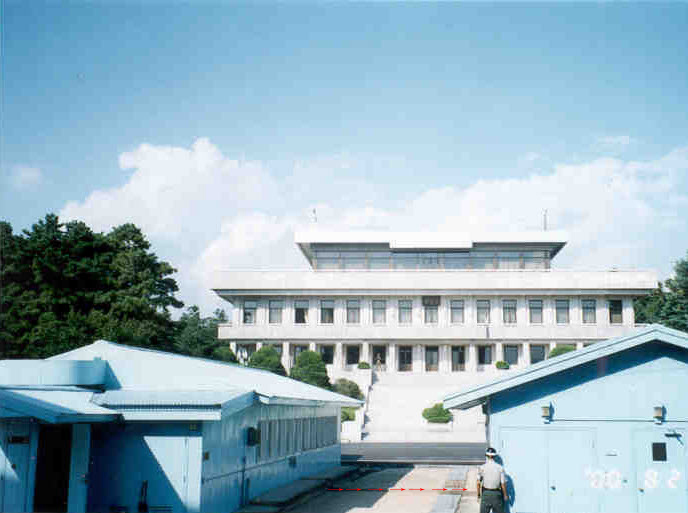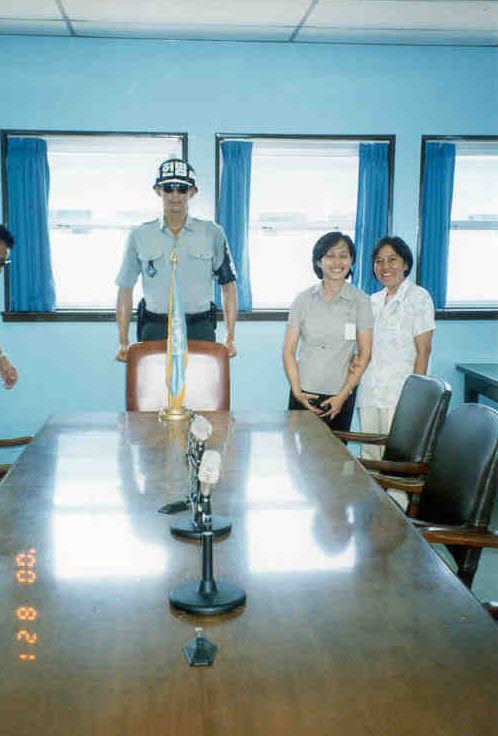Cross That Line...And You’re Dead!
By Gee-Gee O. Torres
When we sent our assistant editor to Korea to meet the 40 or so Pinoy missionaries there we never realized that she would be arriving at a very historic moment in that divided land – divided since the terrible Korean War of the 1950’s. At last the first light of reconciliation seems to be dawning. Gee-Gee Torres shares with us her firsthand account of this momentous event.

August 15 marked a historic milestone in Korea last year. Some 100 North Koreans went to the South and an equal number of South Koreans went to the North to be reunited with their longlost relatives. For 50 years they had never heard from each other – no letters, no phone calls, no nothing. They were victims of the Korean War in the early 1950’s, a bloody civil war which divided not only the nation but also the people. Hundreds and thousands of individuals lost their homes, but what’s much more painful was that they were torn apart from their loved ones. Some relatives ending up in the democratic South and others, the less lucky one, in the communist North.
“What really happened to Korea?” I asked myself. I felt I had to know more about their history to understand the challenges our Filipino missionaries are facing in this land called the Hermit Kingdom. The pressure from the foreign powers was just too much to take that Korea closed its borders to all foreigners in the late 19th century.
When I went to Khangwa Island to visit our Augustinian missionaries I had the opportunity to watch the history of Korea unfold right before my eyes. I was supposed to take my siesta, but the Korean summer afternoon was too humid to be able to dose off. I went to the living room instead and joined Fr. Arlon Vergara, OSA as he watched the live coverage of that historic event, the reunion of families from North and South, on television.
As I watched I couldn’t help but feel for them. I was deeply moved when I saw a middle-aged man visiting his frail, aged mother in the hospital. They embraced each other as if never wanting to let go. Tears rolled down their cheeks. Their faces mirrored the longing of a mother to hold her son and the yearning of a son to be with his mother. After fifty long years, a life-long dream was coming true. When it was time for the son to go, it was so painful for me to hear the mother begging her son not to leave her again and to watch her son go reluctantly, feeling helpless.

Rheena and Mador posing beside the South Korean soldier
My mind drifted back to my childhood days when we would spend our summer vacation in the hometown of my Mom in Pampanga. I always looked forward to be with our Lolo Ambo. I enjoyed watching him dip his pandesal in his coffee every morning while his pet cats joined him for breakfast. Then I would sit beside him at the balcony as he told me stories. However when our summer vacation was about to end I would avoid joining Lolo at the breakfast table or at the balcony. Slowly I distanced myself because I always found it difficult to say goodbye to him. But anyway I could always write him and tell him that I’d see him next summer. But how about the mother and son I saw on TV? It must be doubly hard for them. They have been separated for half a century because of the Korean War and now that they have found each other, once again they have to go through the agony of being separated. The pain could be more bearable if only they had a means of communicating with each other like my Lolo Ambo and me, but up till recently letters and phone calls have not been allowed.
Days after I watched that event on TV, I found myself with Mador and Rheena, two of our Filipina lay missionaries, boarding the tour bus headed to the Demilitarized Zone (DMZ) and Panmunjom, about 56 kilometers north-west of Seoul. We were going to get a glimpse of the forbidden North and Panmunjom is the only place in South Korea along the DMZ where we can get quite so close to North Korea without being arrested or shot. Panmunjom is the truce village on the ceasefire line at the DMZ. Following the Korean War, the DMZ, a 250 kilometers long, 4 kilometers wide no man’s land, strewn with landmines and the world’s most heavily armed border, was set up and has separated the two Koreas since then.
After almost 2 hours we reached Camp Bonifas. At this point I felt the tension in the air. A soldier came up into the bus and inspected our passport. He escorted us into the camp and strictly told us, “No picture taking until advised to do so.” I was tempted to take pictures of the camouflaged bunkers, tanks and artillery but on second thought I decided not to lest I get arrested in the Camp. We had lunch at the commissary and then we proceeded to the lecture room where we were given a slide presentation and briefing by American soldier Stacey, our guide at the DMZ. He asked us to sign a waiver that in case of any untoward incidents they would not be held responsible for us. On our way out of the lecture room, we donned our visitor’s IDs and, escorted by Soldier Stacey, our group boarded a military bus going to the Joint Security Area of Panmunjom. I realized that this wasn’t an ordinary tour at all. Should war break out during our visit, we’d surely get caught in the crossfire.
When we arrived at the Joint Security Area, I stayed close to Soldier Stacey and listened well to his instructions. Stern-looking South Korean soldiers were everywhere. They looked like mannequins standing inside and outside the buildings, but they seemed to be watching our every move, on the alert, making sure that nobody goes near the demarcation line. Across the line was already the communist North. “Cross that line and you’re dead,” Soldier Stacey said as he pointed to us the North Korean guard, watching us closely with his telescope from the other side. Then he directed us to enter a room. We went inside the very room where the endless armistice talks go on. There was a long table in the middle of the room. I was amazed when our guide told us that half of the table belongs to the South and the other half to the North. When Soldier Stacey said we can transfer to the other side of the table Mador, Rheena and I eagerly grabbed our once-in-a-lifetime chance to go to North Korea.
On our way back to Camp Bonifas, I took a last look at the surroundings. It seemed serene but in reality there was tension existing, war could break out anytime. From the bus, we saw the famous Bridge of No Return where prisoners of war were commanded to choose between the North and the South; once they had crossed the bridge it was closed forever. But I believe, in the light of today’s ongoing talks between the governments of the North and the South, in the not too distant future the man I saw on TV will find his way home back to his mother across this bridge. And surely our Pinoy missionaries will soon find themselves following.
